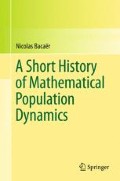Abstract
In 1920 Alfred Lotka studied a predator–prey model and showed that the populations could oscillate permanently. He developed this study in his 1925 book Elements of Physical Biology. In 1926 the Italian mathematician Vito Volterra happened to become interested in the same model to answer a question raised by the biologist Umberto d’Ancona: why were there more predator fish caught by the fishermen in the Adriatic Sea during the First World War, when the fishing effort was low?
Access this chapter
Tax calculation will be finalised at checkout
Purchases are for personal use only
Preview
Unable to display preview. Download preview PDF.
Further reading
Goodstein, J.R.: The Volterra Chronicles, The Life and Times of an Extraordinary Mathematician 1860–1940. American Mathematical Society (2007). books.google.com
Guerraggio, A., Nastasi, P.: Italian Mathematics between the Two World Wars. Birkhäuser, Basel (2005). books.google.com
Israel, G., Gasca, A.M.: The Biology of Numbers – The Correspondence of Vito Volterra on Mathematical Biology. Birkhäuser, Basel (2002)
Kingsland, S.E.: Modeling Nature, Episodes in the History of Population Ecology, 2nd edn. University of Chicago Press (1995). books.google.com
Lotka, A.J.: Analytical note on certain rhythmic relations in organic systems. Proc. Natl. Acad. Sci. 6, 410–415 (1920). www.pnas.org
Lotka, A.J.: Undamped oscillations derived from the law of mass action. J. Amer. Chem. Soc. 42, 1595–1599 (1920). www.archive.org
Lotka, A.J.: Elements of Physical Biology. Williams & Wilkins, Baltimore (1925). www.archive.org
Volterra, V.: Variazioni e fluttuazioni del numero d’individui in specie animali conviventi. Mem. Accad. Lincei 6, 31–113 (1926) Reprinted in: Opere matematiche, vol. 5, Accademia nazionale dei Lincei, Roma (1962)
Volterra, V.: Fluctuations in the abundance of a species considered mathematically. Nature 118, 558–560 (1926). Reprinted in L.A. Real, J.H. Brown (eds.) Foundations of Ecology, pp. 283–285. University of Chicago Press (1991)
Volterra, V.: Leçons sur la Théorie Mathématique de la Lutte pour la Vie. Gauthier-Villars, Paris (1931)
Volterra, V., D’Ancona, U.: Les Associations Biologiques au Point de Vue Mathématique. Hermann, Paris (1935)
Whittaker, E.T.: Vito Volterra 1860–1940. Obit. Not. Fellows R. Soc. 3, 690–729 (1941)
Author information
Authors and Affiliations
Corresponding author
Rights and permissions
Copyright information
© 2011 Springer-Verlag London Limited
About this chapter
Cite this chapter
Bacaër, N. (2011). Lotka, Volterra and the predator–prey system (1920–1926). In: A Short History of Mathematical Population Dynamics. Springer, London. https://doi.org/10.1007/978-0-85729-115-8_13
Download citation
DOI: https://doi.org/10.1007/978-0-85729-115-8_13
Publisher Name: Springer, London
Print ISBN: 978-0-85729-114-1
Online ISBN: 978-0-85729-115-8
eBook Packages: Mathematics and StatisticsMathematics and Statistics (R0)

